Sudan, The Kingdom of the Black Pharaohs
10 days - all accommodated tour + possible extension to Soleb
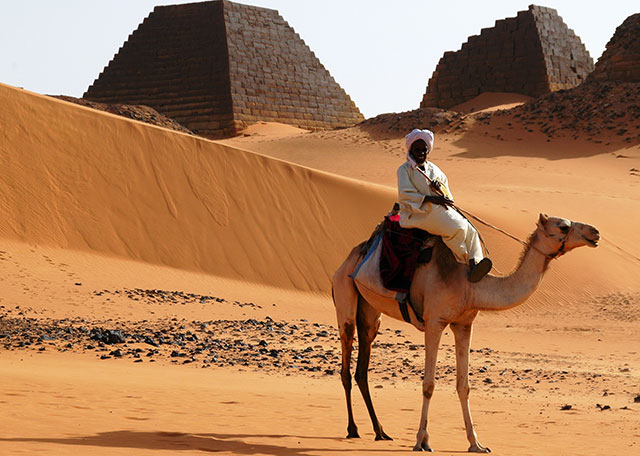
Meroe Pyramids in Sudan
This tour shows all the major archaeological sites of the Northern part of the country. The overnights are in our exclusive properties of Karima and Meroe. This arid and wild region of extraordinary archaeological interest and beautiful landscapes becomes accessible even to those reluctant to sacrifice their comfort.
Possible extension of 3 days to the Third Cataract area with two overnights in a simple but typical private Nubian house.
Itinerary
Day 1: Khartoum arrival
Arrival at Khartoum airport. Meet and greet with the guide and transfer to the hotel. Check in, dinner NOT included and overnight stay.
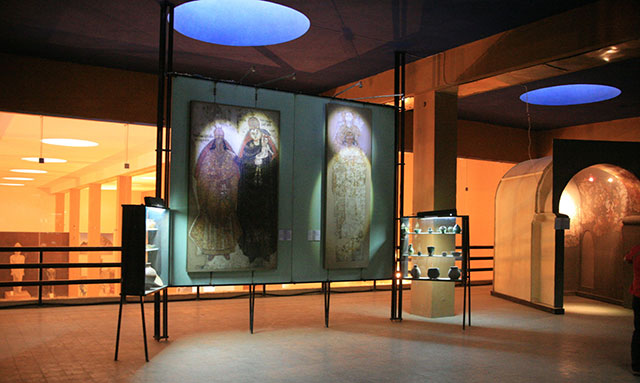
Khartoum Museum
Day 2: Khartoum - city tour and Dervish ceremony (Fridays only)
Breakfast at the hotel. Late in the morning we start the Khartoum city tour. We first visit the Archaeological Museum that, besides many beautiful objects, contains two beautiful temples rescued by UNESCO and moved from the Lake Nasser area, when it was flooded by the water. We then cross the confluence between the Blue and the White Nile near the Presidential Palace where in 1885 General Gordon was beheaded by the Mahdi’s troops and we reach Omdurman, the old capital of Sudan, where we see the Mahdi’s Tomb from outside. Lunch included in a local restaurant on the Nile. In the afternoon we visit the interesting Khalifa’s House which holds a small museum about the Mahdyia (only on Fridays and Saturdays). We then visit the colourful souk of Omdurman. At sunset time we move near the tomb of the sufi leader Ahmed al Nil to assist at the involving Whirling Dervishes Ceremony (only on Fridays). Return to the hotel, dinner not included and overnight. (B.L.)
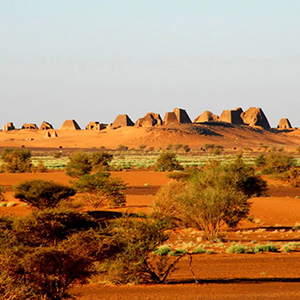
Meroe
Day 3: Khartoum - the temples of Naga and Mussawarat - Meroe
Breakfast at the hotel and then we begin the journey northward. After about 50 km, we get into a desert area covered with huge round granite boulders; these are the last offshoots of the rocky formations of the 6th Cataract. We leave the asphalt road and we drive for about 30 km on a desert track among many camel thorn acacia trees to visit the two archaeological sites. The site of Naga is one of the two centres that developed during the Meroitic period.
In Naga, in a typical Saharan environment with rocks and sand, we find a temple dedicated to Apedemak (1st century A.D.): a wonderful building with bas-relief decorations depicting the god with a lion’s head, the Pharaoh, noblemen and several ritual images. A few metres away there is a small and odd construction with arches and columns, named "kiosk", in which we can notice Egyptian, Roman and Greek styles, all at the same time.
Not far away we reach another temple dedicated to Amon with many statues of rams and beautiful gates decorated with bas-reliefs. We then go to Mussawarat, not far away from Naga. This settlement is located in a beautiful valley crowned by hills. Here the ruins of a very big temple are visible; it once played an exceptional important role. Its main characteristic, the “Great Enclosure” is made by many constructions and boundary walls which surround a temple built in the 1st century A.D. The large number of elephants represented on these walls makes you think that this animal used to have an important role in this area. Beyond the big wadi there is another temple - restored by a German archaeological mission - dedicated to the god Apedemak.
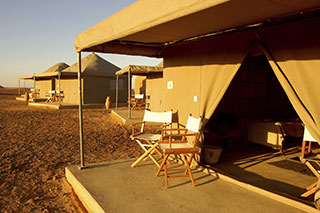 Picnic in the area and then we return on the main road and driving North and all of a sudden, we can glance at more than 40 pyramids, located on top of a hill, some of them perfectly preserved, which belong to the Royal Necropolis of Meroe. Arrival at the Meroe Camp with a beautiful view on the pyramids. Accommodation in comfortable and fully furnished tents, dinner and overnight stay. (B.L.D.)
Picnic in the area and then we return on the main road and driving North and all of a sudden, we can glance at more than 40 pyramids, located on top of a hill, some of them perfectly preserved, which belong to the Royal Necropolis of Meroe. Arrival at the Meroe Camp with a beautiful view on the pyramids. Accommodation in comfortable and fully furnished tents, dinner and overnight stay. (B.L.D.)
The Meroe Camp
Meroe Tented Camp is located in Bagarwyia, (about 230 km. north of Khartoum) overlooking the beautiful pyramids of Meroe. Accommodation consists of 22 twin- bedded tents (4x4 m), tastefully furnished. Each one has its own private bathroom hut with shower and toilet. The Camp is located 2 km from the Royal Necropolis. Each tent is equipped with a veranda with two comfortable chairs to relax in front of the astonishing view of more than forty pyramids. The electricity in the tents is supplied by a generator working till 11:00 pm. There is a restaurant with a nice terrace. The Camp is managed by an Italian manager with the help of well-trained Sudanese staff.
Day 4: Meroe - the Necropolis and the Royal city of Meroe
Morning dedicated to the visit of the pyramids. The Royal Necropolis of Meroe is located at about 3 km from the Nile on some hills covered by yellow sand dunes. Several pyramids stand out with their sharp shapes against the clear sky. Each one has its own funerary chapel with the walls fully decorated with bas-reliefs that show the King’s life and offers to the gods. Lunch at Meroe Camp.
In the afternoon we move along the Nile to visit the ruins of the Royal City. The excavations confirm that the town of Meroe used to cover a large area and the Royal city was located in a central position, surrounded by suburbs and a boundary wall. Most of the area where the city is located, formed by many small hills covered by red clay fragments, has still to be excavated by the archaeologists. Dinner and overnight stay at the permanent Meroe Camp. (B.L.D.)
The archaeological sites of the Meroitic Empire in June 2011 have been listed in the World Heritage UNESCO sites.
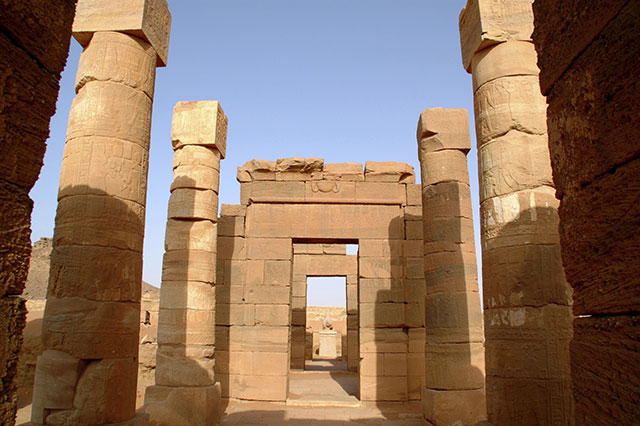
Amon Temple, Naga
Day 5: Meroe - Bayuda Desert - Karima
After breakfast we leave from Meroe and we cross the Nile with the ponton, the local ferry boat, to enter the Bayuda desert. These ferries are a hive of colourful activities. We find ourselves sharing space with people, donkeys, camels and goats. The Bayuda Desert is an area bounded by the loop formed by the Nile between the 4th and the 6th Cataract and characterised by sharp black basalt mountains, most of them volcanic and typically cone-shaped. They alternate with level pebble stretches and large valleys crossed by dry wadis where only little vegetation survives and dorcas gazelles can be seen.
It is very likely to meet isolated groups of Bisharin nomads, who live in familiar groups in small huts made of intertwined branches close to the rare water wells, with their caravans and herds of camels and donkeys. In the first part of the crossing we drive among sand dunes. After some kilometres on the asphalt road, the adventure continue following the Wadi Abu Dom, driving on a sandy track among many acacia trees and some wells where it is possible to meet nomads. Arrival at Merowe, on the Nile, where we across the bridge to reach the comfortable Nubian Rest-House. Dinner and overnight. (B.L.D.)
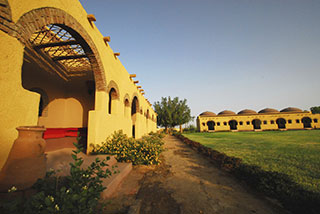 The Nubian Rest - House In Karima
The Nubian Rest - House In Karima
Karima is a small town located on the right bank of the Nile, close to the famous archaeological site at the foot of Jebel Barkal, south of the 4th Cataract. The town is a small, dusty and calm village, where a big market takes place in the morning. The Nubian Rest House is a charming small hotel built in the typical Nubian style just at the foot of Jebel Barkal, the holy mountain of the old Egyptian and Nubian Pharaohs. It is surrounded by a large private enclosure, with a nice garden and leisure area. Each of the 22 A/C rooms is characterized by a peculiar Nubian door with its own private bathroom and a pleasant veranda. The decor and finishing have been carefully selected. They come mainly from Italy and provide an elegant yet rustic charm. A reception, a restaurant and a living room with decorated walls complete the wonderful setting. All the buildings are made with local bricks covered by hand-spread clay plaster as used in the Nubian area. The hotel is managed by an Italian manager with the help of well- trained Sudanese staff.
Day 6: Karima - Jebel Barkal and the necropolis of El Kurru
Landmark in the Nubian Desert, Jebel Barkal ("Jebel" means mountain in Arabic) can be seen from a few dozen kilometres whilst still in the open desert. At the foot of this wonderful and isolated red sandstone mountain, considered holy since the ancient times, there is a big temple, dedicated to the Pharaohs of the New Reign and to their patron, Amon. Amon's ancient "Pure Mountain", the Olympus of the Nubians, was the religious Nubian heart for more than 1000 years. Besides the ruins of the big temple there are still several sculptured granite rams that were supposed to border a long avenue that probably led to the pier on the Nile. In the mountain wall there is a big room decorated with bas-relief. The Jebel Barkal archaeological sites are on the World Heritage list.
The Royal necropolis of the ancient city of Napata, the Nubian capital (from 800 to 400 B.C.) before the Meroitic period, had a large number of pyramids, located in three different places: few hundred metres north of Jebel Barkal; a dozen kilometres southwards from the holy mountain, in El Kurru; in Nuri, which is located on the other bank of the Nile. Lunch in the Nubian Rest House.
We then move southwards to the village of El Kurru where there is one of the necropolises of the ancient capital, Napata. Here we can visit one tomb, which is excavated in the rock under pyramids - partially collapsed - and it is totally decorated with images of the Pharaoh, of the gods and multicolour hieroglyphic inscriptions. Not far from here there is an interesting site of petrified wood, an ancient forest with hundreds of huge trunks. In the late afternoon, return to Karima, accommodation at the Rest-House, dinner and overnight stay. (B.L.D.)
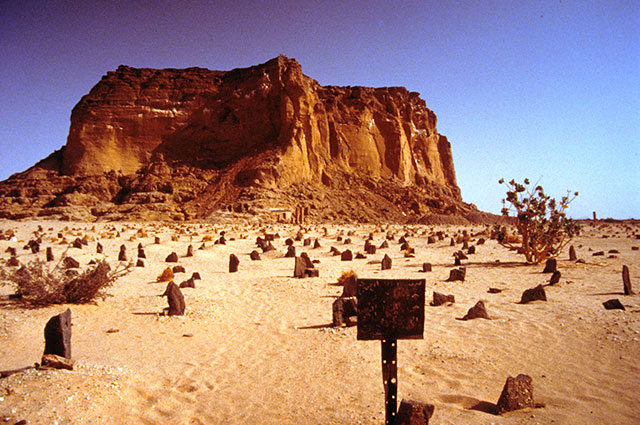
Jebel Barkal
Day 7: Karima - Old Dongola - Karima
Today it is a long day on the road but full of interesting encounters and visits. Early in the morning we will follow the Nile until we reach the archaeological site of Old Dongola. Here there are the rest of a Christian Coptic temple with marble columns as well as several suggestive ruins of churches situated on the banks of the Nile. This area is the central part of the Nubian region.
Here the population lives in small villages amongst yellow sand dunes and palm trees they speak a different language from the Arabs and also the Islamic religion is not as "strict" as in other regions. The women don't cover their faces and readily speak to foreigners. Some houses in the Nubian Villages are painted with pattern of flowers, but most of them are completely white.
We eat our picnic (with our food) in one Nubian house, but the tea and coffee will be prepared by the Nubian family. In the evening return to the Nubian Rest House in Karima. Dinner and overnight stay. (B.L.D.)
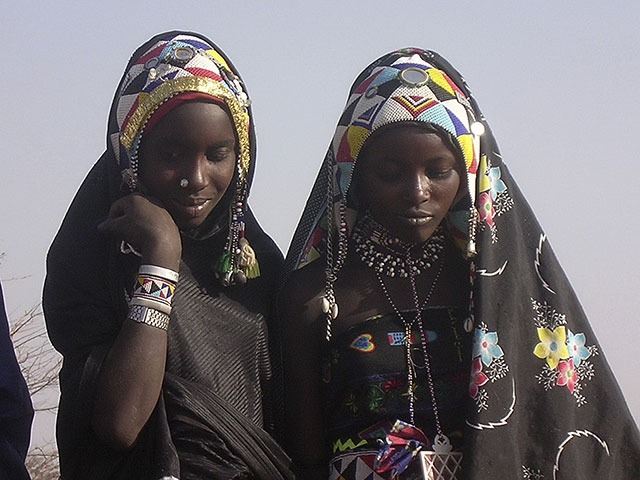
Nuba People
Day 8: Karima - Cruise on the Nile - the Necropolis of Nuri
After breakfast, we visit the market in Karima, where we can have a real experience of the life of Sudanese people. We then board a small motorboat for a pleasant cruise along the Nile to enjoy the beautiful sand stretches and cultivated islands along the river. A little further northward there used to be the beautiful granite rocky formations of the 4th Cataract, which prevented the Nile from flowing slowly and formed many rapids that obstructed the navigation. In April 2008 the Dam of Merowee has been completed and the flooding of the artificial lake started. Picnic in the area. After lunch, we visit the archaeological site of Nuri where we can see many pyramids among which there is also the one of the great Taharqa. Little walk and then return to the Nubian Rest House for dinner and overnight stay. (B.L.D.)
Day 9: Karima - Khartoum
Today we drive south along the tarmac road across the Western Desert. We stop for lunch in a simple “chai house” (a roadhouse where the local truck drivers stop for food and to rest) and in the afternoon we reach Omdurman and we visit the interesting souk, again if required by the group.
Check-in at the hotel where day use rooms will be available until 23.30. Dinner not included. (B.L.)
Day 10: Departure
Transfer and boarding the international flight.
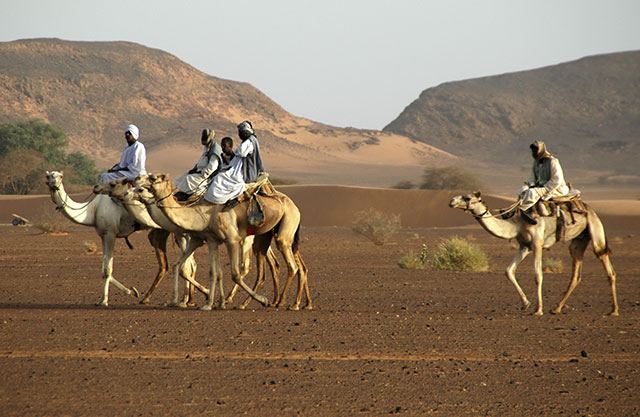
Nubian Desert
Download: 10 Days Sudan, The Kingdom of the Black Pharaohs | 3 Days Extention to Soleb





